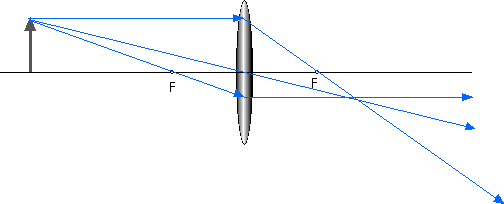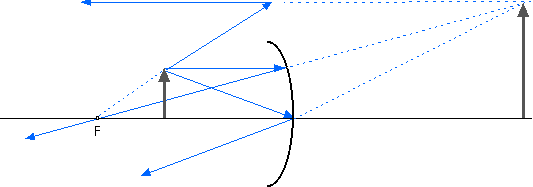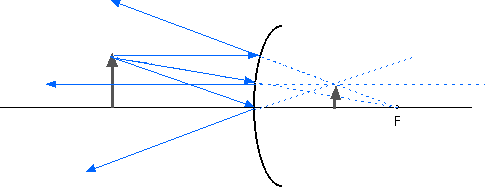Excursions in Physics
Fourth Hour Exam
April 25, 2001
For every question, also consider as a possible answer
E) none of the above
1. Albert Einstein was awarded the Nobel Prize for his work on
the
A) Special Theory of Relativity.
B) General Theory of Relativity.
C) Photoelectric Effect.
At the time (in the 1920's) Relativity was
considered to controversial!
D) Grand Unified Theory (GUT).
2. The “particle-wave duality” of Nature -- the idea that
light (or an electron) may be described as a particle and may be
described as a wave -- is known as the
A) complimentarity principle
This idea was first advocated by Niels Bohr of
the University of Copenhagen.
B) principle of non-simultaniety
C) superposition theorem
D) contradictory principle
3. Light
A) is a mechanical wave
B) is a longitudinal wave
C) has a wavelength between 300 nm and 400 nm
D) all of the above
E) none of the above
4. Light
A) is an electromagnetic wave.
B) is a transverse wave.
C) has a wavelength between 400
nm and 700 nm
D) all of the above
5. The speed of light
A) was too slow for Galileo to measure.
The speed of light was too fast for
Galileo to measure.
B) was measured by Roemer using astronomical
data from the moons of Jupiter
C) was measured by A A Michelson using biological data.
Michelson did, indeed, measure the speed of
light but not with biological data.
D) all of the above
6. Compared to ultraviolet waves,
the wavelength of infrared is
A) longer
B) identical
C) shorter
7. Compared to radio waves, the wavelength of visible light waves in
a vacuum is
A) longer
B) the same
C) shorter
8. Electromagnetic waves consist of
A) compressions and rarefactions of electromagnetic pulses.
B) oscillating electric and magnetic
fields.
C) particles of light energy.
D) high-frequency gravitational waves.
9. The main difference between a radio wave and a light wave is
its
A) speed
B) wavelength
C) EM characteristic
D) all of the above
10. Which of these electromagnetic waves has the shortest
wavelength?
A) X-rays
B) ultraviolet waves
C) infrared waves
D) radio waves
11. The sensation of color is seen when light falls on the eye's
A) rods Rods respond to low light levels but do
not give color information
B) cones
C) cornea This is the front of your eye, where
most of the bending of light occurs
D) ciliary lens This lens is inside your
eye and does the "accomodation" or fine-tuning of image
formation
12. When you see a rainbow, you see

A) red on the inside and violet on the outside
B) yellow on the outside and green on the inside
C) yellow on the inside and green on the outside
D) violet on the inside and red on the
outside
13. The colored dots that make up the color on a TV screen are
A) red, yellow, green
B) red, yellow, blue
C) red,
green,
blue
D) cyan, magenta, yellow
14. Colors seen on TV result from color
A) subtraction
B) addition
C) neither of these
D) either of these

15. Colors seen in paint result from color
A) subtraction
B) addition
C) neither of these
D) either of these


16. Look at a full-color picture in a magazine with a magnifying
glass and you will see that the inks used are
A) red, green, cyan, and blue.
B) red, green, blue, and black.
C)
Cyan,
Magenta,
Yellow,
and
blacK.
(CYMK)
D) cyan, green, yellow, and blue.
17. A mixture of red and
blue light produces
A) blue
B) magenta
C) yellow
D) cyan
18. A sheet of blue paper will
look black when illuminated with
A) red light
B) cyan light
C) blue light
D) magenta light
19. As light passes from glass into air, it is bent
A) toward the perpendicular
B) away from the
perpendicular
20. Refraction causes the bottom of a swimming pool to appear
A) farther away than it really is
B) closer to the surface than it really
is
21. Different colors are dispersed by a prism because different
colors in the spectrum have different
A) angular momenta
B) speeds
C) energies
D) momenta
22. The critical angle for a transparent material is
the angle at and beyond which all light within the material is
totally
A) absorbed
B) reflected
C) refracted
D) polarized
23. Light will not pass through a pair of Polaroid filters when their
axes are
A) parallel
B) rotated 45°
C) rotated 57°
D) perpendicular

24. Consider two Polaroid filters, A and B, rotated 90° with
respect to each other as sketched here:

Now place another Polaroid filter C, between these
two, as sketched here:

As Polaroid filter C is rotated through a full 360°, the
light coming through this combination of filters goes from bright to
dark how many times?
A) none; it remains dark.
B) two times.
C) four times
D) eight times
25. Your vision is sharpest when your pupil is
a) dilated or opened wide
b) constricted or made tiny
c) blue
d) brown
26. Rainbows are a result of
A) dispersion and reflection.
B) dispersion and polarization.
C) reconstruction and polarization.
D) constructive and destructive interference.
27. A single rainbow requires
A) only one reflection inside the
raindrops.
B) two reflections inside the raindrops.
C) constructive interference inside the raindrops.
D) destructive interference inside the raindrops.
28. A double rainbow is a result of
A) one refraction and two reflections.
B) one dispersion and two polarizations.
C) two reconstructions and one polarization.
D) two refractions and two
reflections.
29. A 2-m tall person viewing his full-length image in a plane
mirror requires a mirror that is at least
A) 0.25 m
B) 0.50 m
C) 1.0 m
D) 2.0 m

30. An object is placed 60 cm from a converging lens that has a focal
length of 20 cm. Make a ray diagram of this situation. From
the ray diagram, characterize the image.

The image is
A) real, inverted, and larger.
B) real, inverted, and
smaller.
C) virtual, upright, and smaller.
D) virtual, inverted, and smaller.
31. An object is placed 40 cm from a converging lens that has a focal
length of 20 cm. Make a ray diagram of this situation. From the ray
diagram, characterize the image.

The image is
A) real and inverted (and the same
size)
B) virtual, inverted, and smaller.
C) virtual, upright, and smaller.
D) virtual, inverted, and larger.
32. An object is placed 30 cm from a converging lens that has a focal
length of 20 cm. Make a ray diagram of this situation. From the ray
diagram, characterize the image.

The image is
A) real, inverted, and
larger.
B) real, inverted, and smaller.
C) real, upright, and smaller.
D) virtual, upright, and larger.
33. An object is placed 10 cm from a converging lens that has a focal
length of 20 cm. Make a ray diagram of this situation. From the ray
diagram, characterize the image.

The image is
A) real, inverted, and larger.
B) real, inverted, and smaller.
C) virtual, upright, and smaller.
D) virtual, upright, and
larger.
34. An object is placed 60 cm from a diverging lens that has a
focal length of - 20 cm. Make a ray diagram of this situation.
From the ray diagram, characterize the image.

The image is
A) real, inverted, and larger.
B) real, inverted, and smaller.
C) virtual, upright, and
smaller.
D) virtual, inverted, and smaller.
35. An object is placed 40 cm from a concave mirror that has a focal
length of + 60 cm. Make a ray diagram of this situation.
From the ray diagram, characterize the image.

The image is
A) real, inverted, and larger.
B) real, inverted, and smaller.
C) virtual, upright, and smaller.
D) virtual, inverted, and smaller.
E) none of the above
The image is virtual, upright, and
larger.
36. An object is placed 20 cm from a convex mirror that has a
focal length of - 20 cm.
Make a ray diagram of this situation. From the ray
diagram, characterize the image.

The image is
A) real, inverted, and larger.
B) real, inverted, and smaller.
C) virtual, upright, and
smaller.
D) virtual, inverted, and smaller.
37. The “near point” of a person’s eye is
A) 25 cm
B) the farthest distance at which that person can clearly see an
object
C) the nearest distance at which that person
can clearly see an object
D) infinitly far away
38. The type of lenses needed to correct nearsighted vision is
A) converging
B) diverging
C) convex
D) concave

39. The type of lenses needed to correct farsighted vision is
A) converging
B) diverging
C) convex
D) concave

40. Initially, a camera is focused on some far-distant mountains. It
is then adjusted to focus on a nearby person . To do this, the
lens
a) is moved closer to the film.
b) is moved farther from the
film.
c) is "opened" to larger aperature or larger opening.
d) is "shut down" to a smaller aperature or smaller opening.


41. A simple magnifier produces
A) a virtual image between the lens and your eye
B) a real image between the lens and your eye
C) a virtual image beyond the near point of
your eye
D) a real image at infinity
42. In an optical system with two lenses,
A) the size of the final image is the magnification of the first lens
multiplied by the object
distance of the second lens
B) the magnification of the whole system is the sum of the
magnifications of the two lenses
C) the image produced by the first lens is always virtual
D) the image produced by the first lens can
be treated as an object for the second lens
43. A microscope uses the front lens or objective lens to produce
a
A) virtual image which is right side up.
B) virtual image at infinity.
C) real image which is then viewed through
the eyepiece.
D) real image which is right side up.
44. A telescope uses the front lens or objective lens to produce
a
A) virtual image which is right side up.
B) virtual image at infinity.
C) real image which is then viewed through
the eyepiece.
D) real image which is right side up.
45. A telescope that uses lenses is subject to
A) chromatic abberration.
B) spherical abberration.
C) aspherical abberration.
D) birefringence.
46. A Newtonian telescope is a
A) refracting telescope.
B) polarizing telescope.
C) reflecting telescope.
D) diffracting telescope.
47. We see interference effects if a laser is shined at or through a
double slit (this is Young’s double slit experiment). We do
not see interference effects due to the light coming from two
flashlights because their light is
A) coherent.
B) incoherent.
C) too dim.
D) too bright.
48. Light from a laser is
A) monochromatic
B) in phase
C) coherent
D) all of the above
49. In the interference pattern produced by shining a laser
through two slits (Young's double slit experiment), the bright areas
are the result of
A) destructive interference.
B) polarization.
C) constructive interference.
D) restructive construction.
50. When you view a white light source through a diffraction grating
you will see a brightly colored spectrum with
A) yellow on the outside and green on the inside.
B) yellow on the inside and green on the outside.
C) violet on the inside and red on the
outside.
D) red on the inside and violet on the outside.

PHY 3050G &emdash; Fourth Hour Exam, 4/25/2001



















